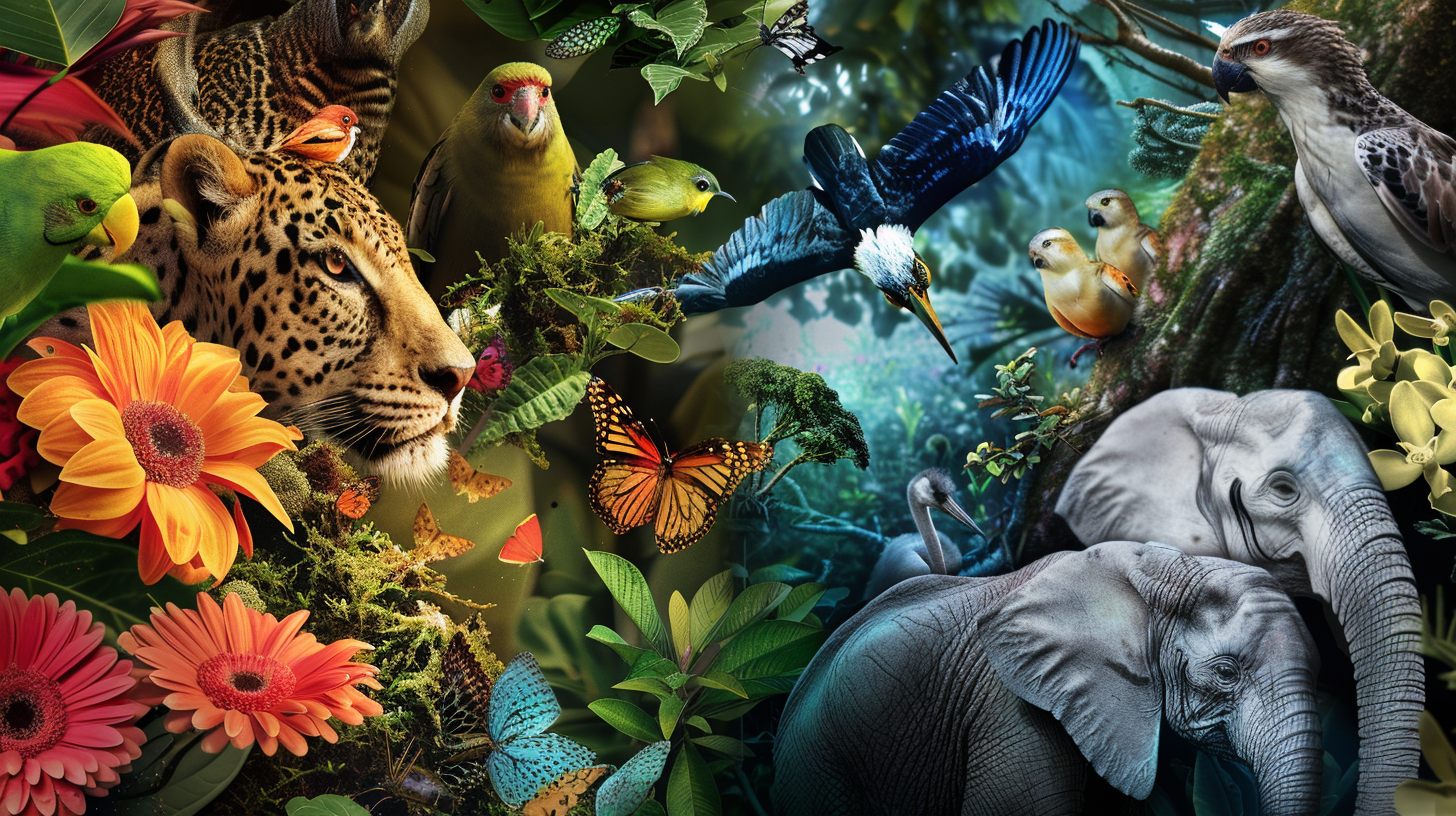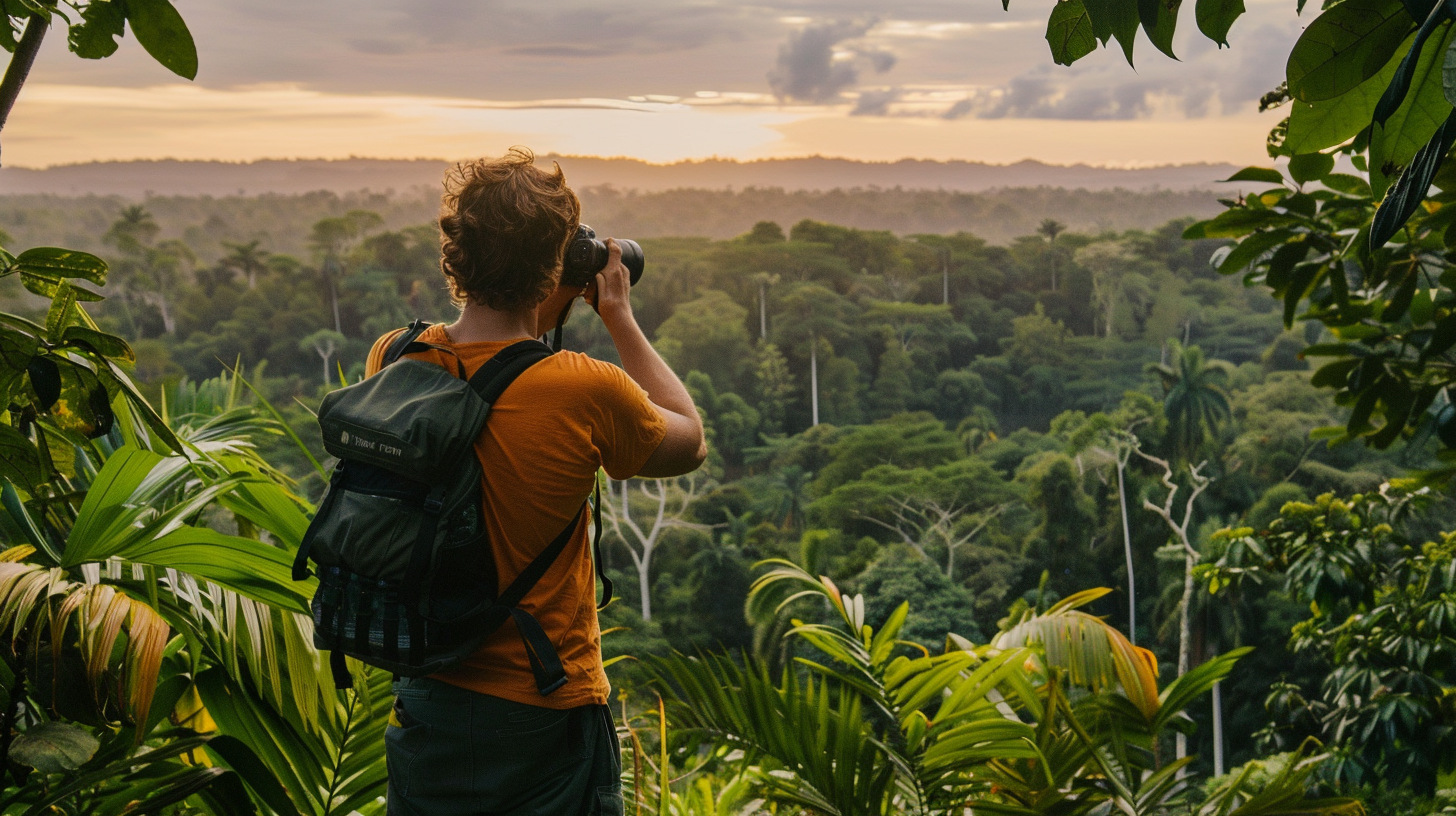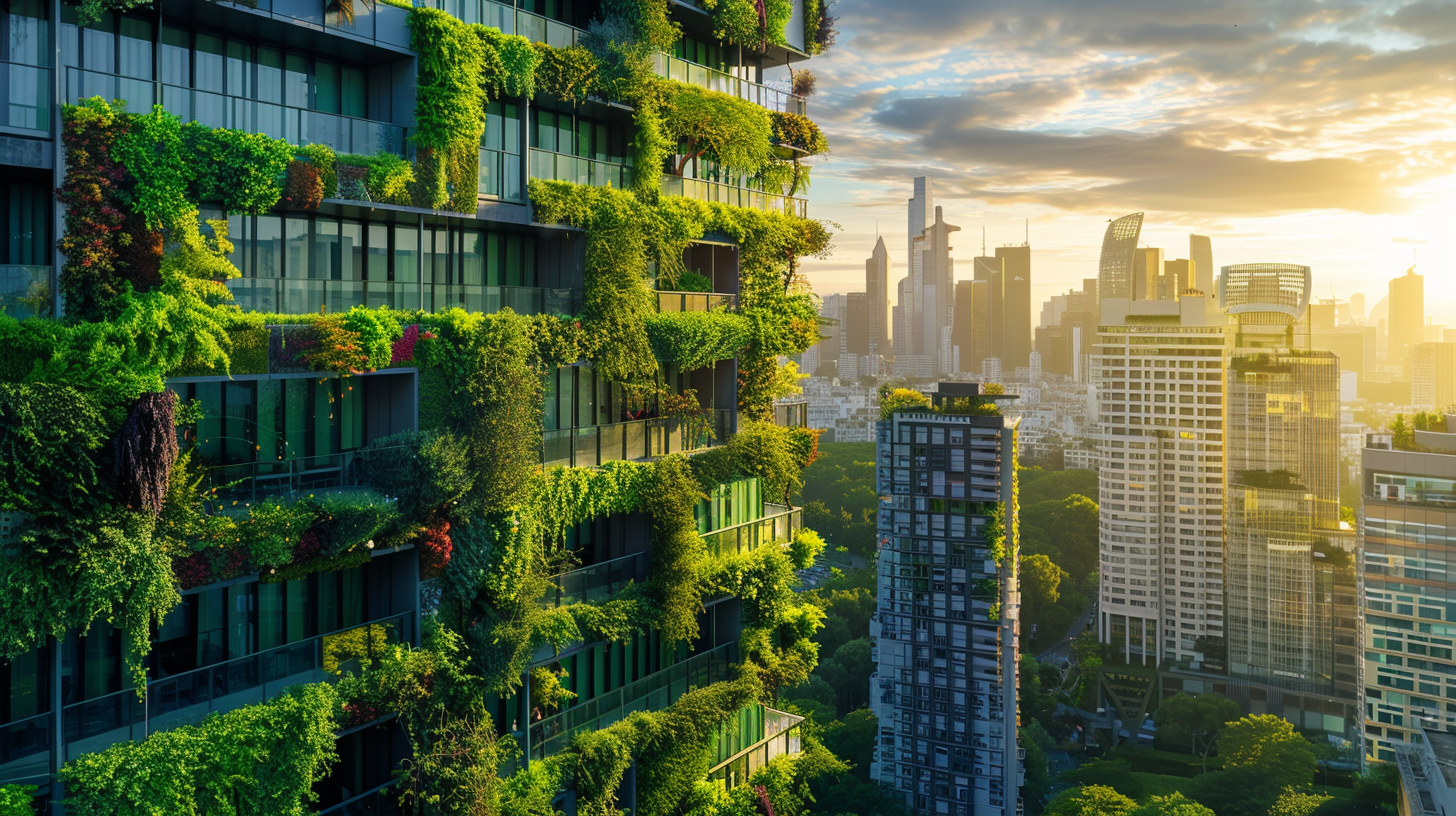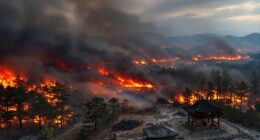Table of Contents Show
Nearly one million species face the threat of extinction, a stark indicator of the biodiversity crisis we’re grappling with globally. As we witness the alarming rate at which species disappear, it’s important for us to understand the driving forces behind this loss and the cascading effects on ecosystems and human well-being. The interplay between climate change and habitat destruction exacerbates this issue, leading to a situation that demands our immediate attention. By exploring the underlying causes and examining the potential solutions, we can begin to address this silent crisis. Let’s consider the steps we can take together to combat biodiversity loss and assure a resilient future for our planet.
Key Takeaways
- Biodiversity loss disrupts ecosystem stability and services, threatening survival.
- Habitat destruction, climate change, and overexploitation are major threats to biodiversity.
- Conservation efforts include protected areas, species conservation, and sustainable development.
- Global action and awareness are crucial to combating biodiversity loss and its impacts.
The Essence of Biodiversity
Biodiversity serves as the lifeblood of our planet, underpinning ecosystems that we rely on for survival. It’s the intricate web of life that connects the smallest microorganism to the largest mammal – and everything in between. This diversity isn’t just about the number of species but also includes genetic diversity and the variety of ecosystems. We’re talking about a treasure trove of life that guarantees natural sustainability for all living things.
We’ve come to realize that our freedom to thrive, to enjoy nature’s bounty, hinges directly on the health of this biodiversity. It’s not just about preserving a pretty landscape or saving iconic species; it’s fundamentally about maintaining the systems that provide us with air to breathe, water to drink, and food to eat. The richness of biodiversity contributes to medicine, agriculture, and even the economy, touching every aspect of our lives.
As we stand together, we acknowledge the urgency to protect this essence of life. The variety of life forms on our planet makes it resilient, capable of withstanding challenges and bouncing back from disasters. It’s this diversity that has allowed life to flourish for billions of years, adapting and evolving through changing climates and geological upheavals.
We’re at a pivotal moment where our actions can safeguard the freedom of future generations to enjoy a planet as vibrant and diverse as the one we’ve been privileged to inherit. Embracing the essence of biodiversity means recognizing our role within this web of life and acting responsibly to preserve it for the well-being of all.
Driving Forces Behind Loss
We’re now turning our attention to the key factors contributing to biodiversity loss. Habitat destruction and climate change stand out as major culprits in this crisis. Let’s explore how these forces drive the decline in global ecosystems.
Habitat Destruction Causes
Habitat destruction, a leading cause of biodiversity loss, is primarily driven by human activities such as deforestation, agriculture expansion, and urban development. We’re carving into the very heart of our planet’s ecosystems for more land to farm, places to live, and resources to consume. It’s our relentless pursuit of growth that’s pushing nature to the brink. Every forest cleared, river dammed, or grassland converted into a shopping mall, we’re not just taking away land; we’re stripping away the homes and food sources of countless species. We’ve got to acknowledge the impact our choices have and start valuing the freedom of all beings to thrive in their natural habitats. It’s time to rethink how we live, work, and grow, ensuring our progress doesn’t come at the cost of the planet’s biodiversity.
Climate Change Impact
While human activities like deforestation and urbanization greatly harm ecosystems, climate change further amplifies the threat to global biodiversity. It’s not just about warmer temperatures; it’s about how these changes disrupt the delicate balance of life. We’re seeing:
- Species migration: Animals and plants are forced to move to cooler areas, leading to competition and extinction.
- Coral bleaching: Warmer oceans are devastating coral ecosystems, essential for marine life.
- Changes in breeding patterns: Altered climates disrupt the breeding cycles of various species, affecting their survival.
- Increased disease: Warmer climates foster the spread of diseases that affect wildlife, plants, and humans alike.
We’re in this together, fighting for a planet where freedom for all species to thrive isn’t just a dream. It’s a necessity.
Global Impacts on Ecosystems
As we explore the global impacts on ecosystems, it’s clear that the consequences of biodiversity loss are profound. Altered natural habitats, threatened species survival, and the decline in ecosystem services are just the tip of the iceberg. We’ll examine how these factors intertwine to undermine the health and stability of our planet’s ecosystems.
Altered Natural Habitats
Often, human activities drastically alter natural habitats, threatening the balance of global ecosystems. We’re witnessing a silent crisis that impacts our freedom to enjoy nature’s diversity. Here’s why preserving these habitats is important:
- Sustains Ecosystem Services: Healthy habitats provide clean air, water, and fertile soil.
- Supports Economic Freedom: Diverse ecosystems fuel industries like agriculture, fishing, and tourism.
- Promotes Resilience: Intact habitats are better at withstanding natural disasters, safeguarding communities.
- Ensures Future Choices: Protecting habitats preserves a range of options for future generations.
We must recognize that our actions have far-reaching consequences. By valuing and protecting natural habitats, we safeguard the planet’s health, ensuring freedom and prosperity for all species, including ourselves.
Threatened Species Survival
Building on the importance of protecting natural habitats, we now turn our attention to the survival of threatened species and their profound impact on global ecosystems. When we allow species to edge closer to extinction, we’re not just losing individual animals or plants; we’re risking the collapse of entire ecosystems that depend on the delicate balance these species maintain. It’s about safeguarding our freedom to coexist with a diverse array of life that sustains the planet’s health and our own well-being. We’ve got to recognize that each species plays a unique role in its ecosystem, acting as a thread in the intricate tapestry of life. Pull one out, and we risk unraveling the whole. It’s time we take collective action to safeguard the survival of these threatened species, safeguarding the freedom and diversity of life on Earth.
Ecosystem Services Decline
The decline in ecosystem services greatly impacts global ecosystems, affecting both human well-being and biodiversity. We’re witnessing a worrying trend where the services our planet has freely offered are diminishing. This not only threatens our freedom to thrive but also the very health of our planet. Here’s what we’re losing:
- Clean water – Nature’s filtration system is faltering, affecting our access to pure water.
- Pollination – A decrease in pollinators endangers food crops and natural vegetation.
- Climate regulation – The balance that keeps our climate stable is being disrupted.
- Soil fertility – Erosion and degradation reduce arable land, compromising food security.
We must recognize the urgency of this crisis and act to preserve the freedom of our ecosystems to support life.
Consequences for Human Well-being
Biodiversity loss directly undermines human health, food security, and access to clean water, fundamentally threatening our well-being. We’re witnessing a decline in nature’s pantry, which means less variety on our plates and a direct hit to the cultures and economies that rely on specific species for their livelihoods. It’s not just about missing out on the next potential superfood. It’s about jeopardizing the very foundation of our sustenance.
We’re also facing a health crisis as natural buffers against diseases diminish. The intricate web of life that once acted as a barrier protecting us from various pathogens is unraveling. We’re losing our natural allies in medicine discovery as plants and animals, potential sources of new drugs, disappear before we even know they exist. This isn’t just a loss; it’s a closing window of opportunity to fight diseases that threaten our communities.
Additionally, the decline in biodiversity affects the quality and availability of water. Natural landscapes like forests, wetlands, and grasslands play a critical role in filtering and regulating our water supplies. As these ecosystems degrade, we’re left grappling with the consequences – more frequent water shortages and increased purification costs that we can scarcely afford.
We must acknowledge that our freedom to thrive, to enjoy good health, and to prosper is intrinsically linked to the health of our planet’s ecosystems. The consequences of biodiversity loss aren’t just environmental issues; they’re a direct threat to our liberty to live well. We can’t afford to ignore this any longer. It’s time we recognize the value of nature in our lives and take urgent steps to protect it.
The Role of Climate Change
Climate change greatly intensifies the threats to global biodiversity, altering ecosystems at an unprecedented pace. We’re witnessing a silent crisis that’s reshaping the world around us, demanding our immediate attention and action. The freedom to enjoy our planet’s rich diversity hangs in the balance, and it’s up to us to safeguard it for future generations.
The effects of climate change on biodiversity are multifaceted, but here are four key impacts that stand out:
-
Shifts in Habitats: Species are forced to migrate to cooler areas, disrupting the balance of ecosystems. This migration isn’t just a change of address; it’s a fight for survival, with many unable to adapt quickly enough.
-
Changes in Seasons: Altered seasonal patterns confuse the life cycles of many species. Birds might migrate at the wrong time, plants may bloom too early, and breeding seasons can get out of sync, leading to mismatches in ecosystems.
-
Increased Frequency of Extreme Weather Events: More frequent and intense droughts, floods, and storms not only destroy habitats but also put immense stress on species, pushing them toward extinction.
-
Ocean Acidification: The increased absorption of CO2 by our oceans is making them more acidic, harming marine biodiversity. Coral reefs, the ocean’s rainforests, are bleaching and dying at alarming rates, affecting countless species that depend on them.
We’ve got the power to change the trajectory we’re on, but it requires us to act swiftly. Protecting our planet’s biodiversity isn’t just about saving other species; it’s about preserving the freedom to live on a vibrant, thriving Earth.
Loss of Specific Habitats
Several specific habitats are under severe threat, directly impacting the species that depend on them for survival. We’re talking about the ancient forests, vibrant coral reefs, expansive grasslands, and intricate wetlands that make our planet so crucial and resilient. These places aren’t just beautiful; they’re essential. They provide us with air to breathe, water to drink, and food to eat. Yet, we’re losing them at an alarming rate.
We’re witnessing a dramatic shrinkage in these crucial areas due to a variety of human activities. Forests are being cleared for agriculture and urban development, coral reefs are bleaching due to rising sea temperatures, grasslands are being overgrazed, and wetlands are being drained for construction projects. Each loss is a blow to biodiversity, reducing the variety of life on Earth and weakening the ecosystems that sustain us.
It’s not just about the animals and plants that we’re familiar with; it’s about the countless species that haven’t been discovered yet, the natural medicines that could be lost, and the cultures that depend on these habitats for their way of life. We’re all connected in this web of life, and when one strand weakens, we all feel the effects.
We can’t stand by and watch these habitats disappear. It’s time to acknowledge the value of these places, not just for the creatures that inhabit them, but for all of us. We’ve got the freedom to make choices that can protect and restore these crucial ecosystems. Let’s use it.
Conservation Efforts Worldwide
Across the globe, numerous countries are taking significant steps to protect and restore vital ecosystems, recognizing their importance for the planet’s health and our own survival. We’re witnessing an era where conservation isn’t just a choice; it’s a necessity for our freedom to thrive in a healthy environment. Our collective efforts are shining a light on the path towards sustainability and biodiversity preservation.
The strategies we’re employing are diverse, yet they all share the common goal of ensuring a vibrant planet for future generations. Here’s what’s happening:
-
Expanding Protected Areas: Countries are designating more lands and waters as protected areas, safeguarding them against the threats of development and exploitation. This isn’t just about keeping these places untouched; it’s about preserving our right to experience the natural world in its fullest glory.
-
Strengthening Legislation: There’s a global push for stronger environmental laws that not only prevent habitat destruction but also provide the legal framework necessary for the rehabilitation of already damaged ecosystems. This legal armor empowers us to hold offenders accountable, defending our planet’s diversity.
-
Community Involvement: Recognizing that local communities are the custodians of their environments, there’s a growing emphasis on involving them in conservation projects. Their traditional knowledge and direct stake in the outcome make them indispensable allies in our fight against biodiversity loss.
-
Financial Investments in Conservation: Governments and NGOs are funneling more resources into conservation programs, understanding that financial investment is crucial for achieving long-term sustainability goals. This funding is the fuel driving the engine of our global conservation efforts, ensuring we have the means to protect the freedom of all species to exist and flourish.
Our commitment to conservation is a proof of our desire for freedom—freedom to live in a world where nature thrives alongside humanity.
Innovative Solutions to Restore
In our quest to combat biodiversity loss, we’re turning to a multitude of innovative solutions aimed at restoring ecosystems worldwide. We’re embracing cutting-edge technologies and strategies that promise not only to halt the decline but to rejuvenate the natural world. Our commitment to freedom and innovation propels us forward, seeking out paths less traveled to vital the survival and flourishing of diverse species.
Here’s a glance at some of the pioneering approaches we’re rallying behind:
| Technology/Strategy | Description | Potential Impact |
|---|---|---|
| Rewilding | Reintroducing species to their natural habitats to restore ecological balance. | Enhances biodiversity and revitalizes ecosystems. |
| Bioengineering | Using genetic modification to strengthen species’ resilience against climate change. | Preserves endangered species and improves ecosystem health. |
| Artificial Intelligence & Robotics | Employing AI and robots to monitor and manage wildlife and habitats. | Increases efficiency in conservation efforts and data collection. |
We’re also exploring the potential of nature-based solutions, such as the restoration of peatlands and mangroves, which serve as natural carbon sinks while providing critical habitat for wildlife. By investing in these innovative approaches, we’re not only addressing the immediate threats to biodiversity but also paving the way for a future where nature and humanity thrive together.
Our freedom to innovate and adapt is our greatest asset in this fight. We’re committed to exploring every avenue, leveraging every tool at our disposal, to vital the richness of our planet is preserved for generations to come. This journey demands our creativity, resilience, and collective action. Let’s embrace these solutions with open arms and open minds, forging a path to a more biodiverse, sustainable world.
Mobilizing for Collective Action
We’re uniting communities and organizations worldwide to harness collective power in tackling the challenge of biodiversity loss. This isn’t just about saving trees and animals; it’s about preserving our freedom to thrive in a world that cherishes diverse life. The time to act is now, and here’s how we’re mobilizing for collective action:
- Creating Awareness: We’re spreading the word, educating people about the critical role biodiversity plays in our survival. It’s not just an environmental issue; it’s a freedom issue. The more knowledge we have, the better we can act.
- Building Alliances: From grassroots movements to global organizations, we’re pooling our resources, knowledge, and passion. Together, united, we’re stronger and can make a significant impact.
- Influencing Policy: We’re engaging with policymakers to advocate for laws and regulations that protect biodiversity. It’s about making our voices heard and ensuring our freedom to live in a balanced ecosystem is protected.
- Promoting Sustainable Practices: We’re championing sustainable living and business practices that minimize harm to the environment. Every choice we make can contribute to a healthier planet.
In a nutshell, we’re not just fighting against biodiversity loss; we’re fighting for our right to a future where freedom and nature coexist harmoniously. It’s a monumental task, but together, united, we have the power to make a difference. Join us as we mobilize for collective action. It’s our world, our responsibility, and our freedom at stake.
Conclusion
We’re at a crossroads, with biodiversity loss casting a long shadow over our planet’s future. Like threads unraveling from the tapestry of life, each species lost weakens the fabric of ecosystems we rely on. Climate change and habitat destruction are the scissors cutting these threads. Yet, hope isn’t lost. Through global conservation efforts and innovative solutions, we can reweave this tapestry, stitching together a future where humans and nature thrive side by side. It’s time we all join hands in this crucial endeavor.








